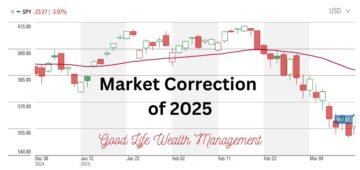With corporate pensions declining in use, retirees are increasingly dependent on withdrawals from their 401(k)s, IRAs, and investment accounts. The challenge facing investors is how to plan these withdrawals and not run out of money even though we don’t know how long we will live or what returns we will receive in the market on our portfolio.
Pensions and Social Security provide a consistent source of income that you cannot outlive. When I run Monte Carlo simulations – computer generated outcomes testing thousands of possible scenarios – we find that the larger the percentage of monthly needs that are met from guaranteed sources, the lower chance the investor will run out of money due to poor market performance from their portfolio.
If you do have a pension, it is very important to consider all angles when deciding between a lump sum payout and participating in the pension for the rest of your life. It is not a given that you will be able to outperform the pension payments, especially if you are healthy and have a long life expectancy.
The most obvious way to avoid running out of money (called longevity risk by financial planners) would be to annuitize some portion of your portfolio through the purchase of an immediate annuity from an insurance company. While that would work, and is essentially the same as having a pension, very few people do this. You’d be giving up all control of your assets and reducing any inheritance for your beneficiaries. With today’s low interest rates, you’d probably be less than thrilled with the return. For example, a 65-year old male who places $100,000 in a single life immediate annuity today would receive $542 a month.
The problem with annuitization, besides giving up your principal and not leaving anything for your heirs, is that it doesn’t allow for any increase in expenditures to account for inflation. There are three approaches we might use to structure a withdrawal program for a retiree.
1) Assume a fixed inflation rate. In most retirement planning calculators, projected withdrawals are increased by inflation to maintain the same standard of living. After all, who doesn’t want to keep their standard of living? The result of this approach is that the initial withdrawal rate then must be pretty low. 20 years ago, the work of William Bengen established the “4% rule” which found that a withdrawal rate of 4% would fund a 30-year retirement under most market conditions.
On a $1 million portfolio, 4% is $40,000 a year. But that is just the first year. With 3% inflation, we’d plan on $41,200 in year two, and $42,436 in year three. After 24 years, withdrawals would double to $80,000. The 4% rule is not the same as putting your money in a 4% bond; it’s the inflation which requires starting with a low initial rate.
While we should plan for inflation in retirement, this method is perhaps too rigid in its assumptions. If a portfolio is struggling, we’re not going to continue to increase withdrawals by 3% and spend the portfolio to zero. We have the ability to respond and make adjustments as needed.
2) Take a flexible withdrawal strategy. We may be able to start with a slightly higher initial withdrawal rate if we have some flexibility under what circumstances we could increase future withdrawals. In my book, Your Last 5 Years: Making the Transition From Work to Retirement, I suggest using a 4% withdrawal rate if you retire in your 50’s, a 5% rate if you start in your 60’s, and 6% if retiring in your 70’s. I would not increase annual withdrawals for inflation unless your remaining principal has grown and your withdrawal rate does not exceed the original 4, 5, or 6%.
This doesn’t guarantee lifetime income under all circumstances, but it does give a higher starting rate, since we eliminate increases for inflation if the portfolio is shrinking. Under some circumstances, it may even be prudent to reduce withdrawals to below the initial withdrawal amount temporarily. That’s where having other sources of guaranteed income can help provide additional flexibility with your planning.
3) Use an actuarial method. This means basing your withdrawals on life expectancy. Required Minimum Distributions (RMDs) are a classic example of an actuarial strategy: you take your account value and divide by the number of years of life expectancy remaining. If your life expectancy is 25 years, we take 1/25, or 4%. The next year, the percentage will increase. By the time someone is in their 90’s, their life expectancy will be say three years, suggesting a 33% withdrawal rate, which may work, but obviously will not be sustainable. However, the more practical problem with using the RMD approach is that many people aren’t able to cut their spending by 20% if their portfolio is down by 20% that year. So even though it has a sound principle for increasing withdrawals, the withdrawal amounts still require flexibility based on market results.
But there are other ways to use the actuarial concept, and even my approach of different rates at different retirement ages is based on life expectancy. There’s no single method that will work in all circumstances, but my preference is to take a flexible strategy. But this does mean being willing to reduce spending, and forgo or even cut back inflation increases, if market conditions are weak.
We have a number of different tools available to evaluate these choices throughout retirement, but the other key factor in the equation is asset allocation. Bengen found that his 4% rule worked with equity allocations between 50% and 75%. Below 50% equities, the portfolio struggles to keep up with inflation and withdrawals become more likely to deplete the assets in the 30-year period. Above 75% equities, the portfolio volatility increases and rebalancing benefits decrease, increasing the number of periods when the 4% strategy would have failed.
When sorting through your options, you need candid and informed advice about what will work and under what circumstances it would not work. We hope for the best, but still have a plan for contingencies if the market doesn’t cooperate as we’d like. We will be able to consider all our options as the years go by and be proactive about making adjustments and corrections to stay on course. For any investor planning for a 30-year retirement, it’s not a matter of if the market will have a correction, but when. It’s better to have discussed how we will handle that situation in advance, rather than waiting until the heat of the moment.







